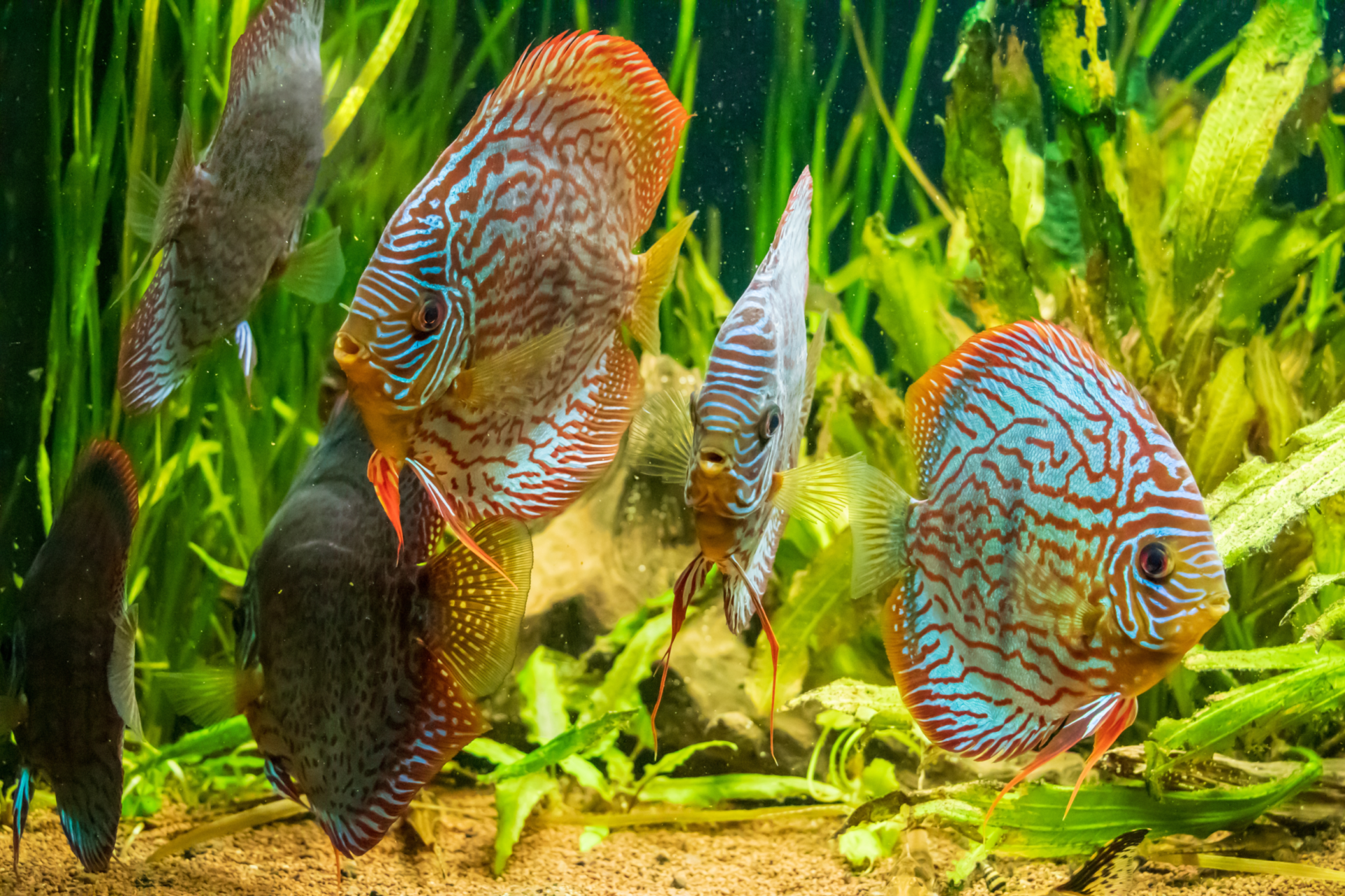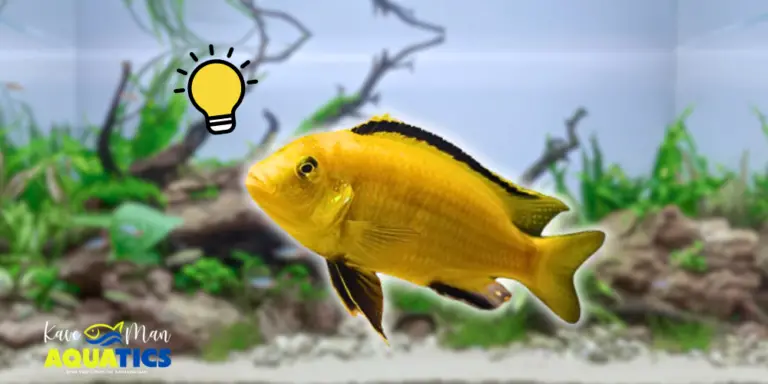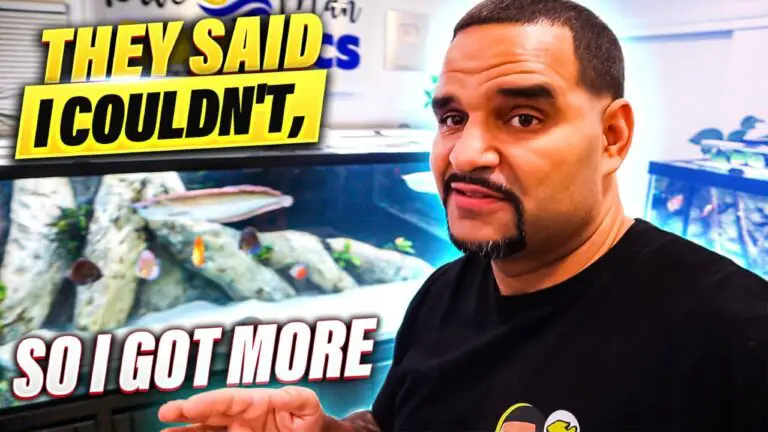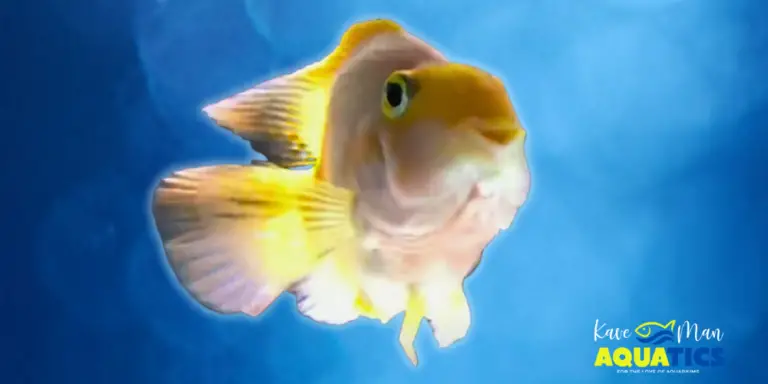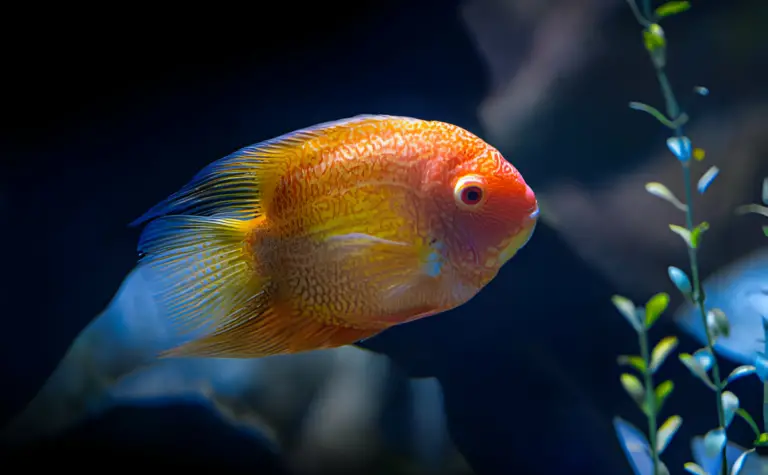Discus Fish Care Guide (5 Things You Must Know)
Discus fish are among the most colorful freshwater fish! Captivated by their beauty, you’re compelled to add them to your collection. But, before you buy any new fish, do your homework (this goes for both beginners and the experienced)!
As they are part of the Cichlidae family, Discus fish are beautiful but can be difficult to keep.
And that’s why we’ve created this Discus fish care guide for you. After reading this blog, you’ll know more about the proper care of the “king of the aquarium fish.”
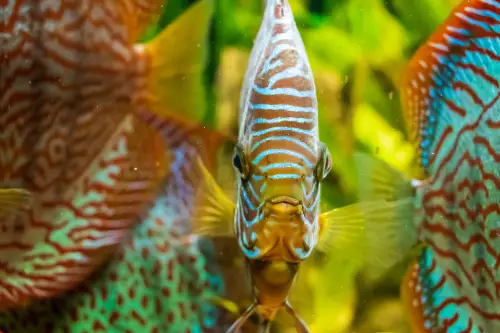
Discus Fish Care Guide: Overview
| Family | Cichlidae |
| Scientific Name | Symphysodon |
| Species | S. Aequifasciatus (blue or brown Discus), S. Discus (red or Heckel Discus), S. Tarzoo (green Discus) |
| Common Names | Discus fish, Pompadour fish, King of the aquarium |
| Location | Amazon river basin, South America |
| Size | 4.6 – 8 inches (12.3 – 15.2 centimeters) |
| Life Expectancy | 10 – 15 years average (in captivity) |
| Appearance | Round/Disc-shape, flat sides |
| Color | Blue, brown, red, green, and other colors with a variety of patterns and markings |
| Diet | Omnivores |
| Behavior | Peaceful and shy (may become territorial when breeding) |
| Tank Size | 10 gallons (45.4 liters) per Discus |
| Temperature | 82 – 88 °F (28 – 31 °C) |
| pH | 6.0 – 7.0 |
| Water Type | Freshwater |
| Hardness | Soft, 3 – 8 GH |
| Care Level | Difficult |
| Breeding | Difficult |
Natural Habitat
Discus fish can be found in the Amazon river basin, including the Rio Negro area. The blue Discus gravitate toward the eastern side of the basin and the green Discus more toward the western side. The red Discus is native to the Rio Negro area.
All these guys prefer quiet waters and are rarely seen in waters with strong currents. tend to congregate near fallen trees, known as “galhadas”, along the shore. Discus fish hide away in shaded areas and breaks in the water flow created by fallen trees or small inlets.
Appearance
Discus fish got their name from, well, their flat and disc-shaped appearance. Some may vary with a rounder or more elongated appearance. They have rounded anal and dorsal fins and have a pronounced caudal fin and pelvic.
Of course, Discus fish are popularly known for their variety of colors and patterns. This means that you can find a diverse type of Discus that will make any aquarium breathtakingly beautiful!
Behavior
Their peaceful personalities (and beauty) make up for their difficulty in keeping. They are shy and intelligent fish. They thrive in a group of six or more. But, as with any fish in the Cichlidae family, they’ll compete with each other to establish a “tank boss.” Naturally, they also become territorial during breeding.
Shy and submissive Discus fish that cannot compete will need to be separated from the “tank bullies.”
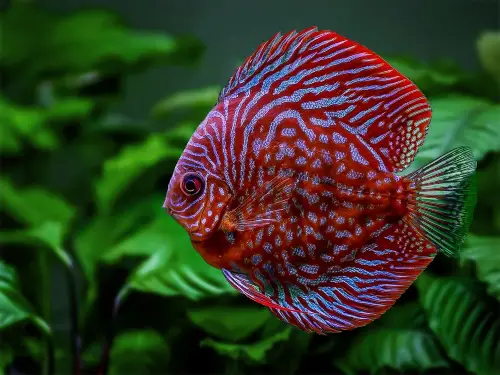
Tank Requirements
Please ensure that before adding any new fish to a tank, it’s properly cycled. That’s where a quarantine tank can be very valuable.
| Tank Size | 10 gallons (45.4 liters) per Discus |
| Temperature | 84 – 86 °F (28 – 31 °C) |
| pH | 6.0 – 7.0 |
| Water Type | Freshwater |
| Hardness | Soft, 3 – 8 GH |
| Substrate | Sand, pebbles, rocks (they are foragers) |
| Filter | Yes, a filter is required as Discus produce a large amount of waste and stir up the substrate. They don’t do well in tanks where nitrogen levels are spiking or unstable. |
| Plants | Yes, live plants (oxygen supply, Nitrate reduction, compliments Discus’ colors) and driftwood (lowers pH and GH of water). |
Tank Size
Bigger is always better. Considering the size that Discus can grow, a minimum of 55 gallons are required for a tank of 6 Discus. A general rule of thumb is 10 gallons per 1 fish. Their disc shape gives them a tall appearance – so shallow tanks are not ideal.
Temperature
The ideal temperature for Discus fish is between 84 – 86 °F. Yes, unlike most other tropical fish, Discus prefer warmer water. Take note that warmer water’s ability to hold oxygen is lower – make sure that your tank is well aerated.
Keep in mind that most aquarium plants don’t do well with higher temperatures. Hardy plants such as bucephalandra, anubias, and java fern can be used.
pH and Hardness
Discus fish prefer soft, acidic water. The pH levels can range from 6.0 – 7.0 and the GH can range from 3 – 8. Now, it’s not impossible for Discus to keep healthy with slightly higher pH and GH levels. Test the water parameters frequently to ensure you maintain a healthy and thriving environment for your fish.

Diet
Captive Discus fish need a varied diet of Cichlid food, protein-rich supplements, live, freeze-dried, and frozen food. Being omnivores, Discus fish can eat both meat (insects, worms, crustaceans, shrimp pellets, tropical flakes) and plant (algae rounds, corn flakes) materials.
They are quite picky eaters. Try to rotate the food in their diet to prevent them from sticking to only ever going after one food.
Given their flat body shape and small mouths, they can’t gorge on large food portions and require smaller amounts when it’s meal time. If you see the fish-eating food and spit it out, it indicates a problem with the food size.
When it comes to how often you should feed your Discus, feed them no more than 3% of their body weight. On average, adult Discus should be fed 2 – 3 times per day.
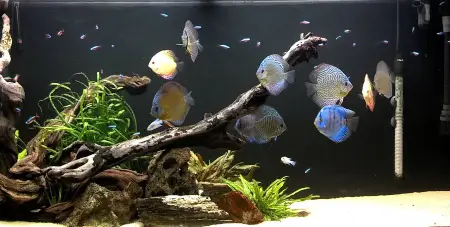
Tank Mates
Being an overall peaceful fish, they too require peaceful tank mates. If their tank mates are too big or aggressive, they might be bullied or get eaten themselves.
| Best tank mates for Discus fish | Worst tank mates for Discus fish |
|---|---|
| Cardinal tetras | African Cichlids |
| Neon tetras | Oscar fish |
| Glowlight tetras | Goldfish |
| Hatchetfish | Green Terror |
| Sterbai cory catfish | |
| Plecostomus catfish | |
| Clown loaches | |
| Dwarf Cichlids |
If you already have fish that are not compatible with your Discus fish, you can either build a new tank or rehome some of your fish to make room. We at KaveMan Aquatics had to make the decision too – to rehome some of our fish to make room for the new additions to the fish family.
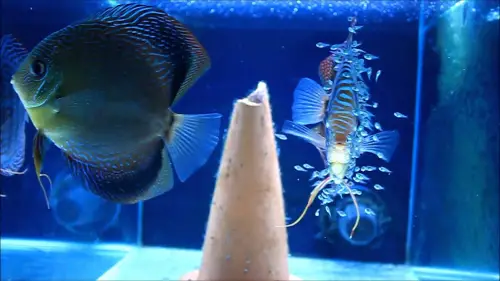
Breeding
Discus fish are difficult to breed. Captive bred discus will pair up and spawn relatively easily, but young, inexperienced parents may eat their eggs the first few times, particularly if other fish are present.
It is, however, challenging to identify a breeding pair. Male and female discus both take two to three years to reach sexual maturity, and there’s no noticeable difference between the sexes.
When two of your group become territorial, move them to a breeding tank that is at least 36 x 18 x 18 inches in size. Check that the water, temperature, and food are all optimal. The breeding tank’s bottom should be bare to facilitate cleaning. To serve as egg-laying surfaces, include driftwood, flat rocks, or vertical cones.
Some Discus fish owners add an upturned clay pot in the breeding tank to encourage them to lay eggs as it provides a hard surface.
Following spawning, the discus fish will guard their eggs. The eggs should hatch within a few days after spawning and the fry will take another few days to develop before they become free swimming. The free-swimming fry will then begin to follow their parents around the tank, feeding off of the layer of mucus that forms on the bodies of the adult discus fish.
Conclusion
We hope you found this article reassuring in your Discus fish ventures. The main takeaway from this Discus fish care guide is to reduce stress. Making these shy creatures feel safe in a thriving environment will go a long way in enhancing their health and quality of life.
Many new Discus fish owners fixate and worry too much about their fish and this may cause an incident. Relax, follow this Discus fish care guide, and appreciate them. You’re well on your way to having a successful Discus fish tank.
Remember to enjoy the journey. Speaking of journeys… we are also proud owners of Discus fish. Enjoy the journey with us!
Thank With Google
By the way, we’re excited to be one of Google’s paid early testers for their Thank with Google pilot program! Thank with Google is an experimental feature that allows you to purchase a virtual sticker and directly show your appreciation for content on this website!
There are a variety of stickers to select from, including free ones, and every time you send a paid sticker you can add a personal message for me! The virtual stickers translate into direct revenue that supports the website, channel, and brand. You can find the Thank with Google feature in multiple places on my site. If you try it out, let me know what you think! As always, thanks in advance!

